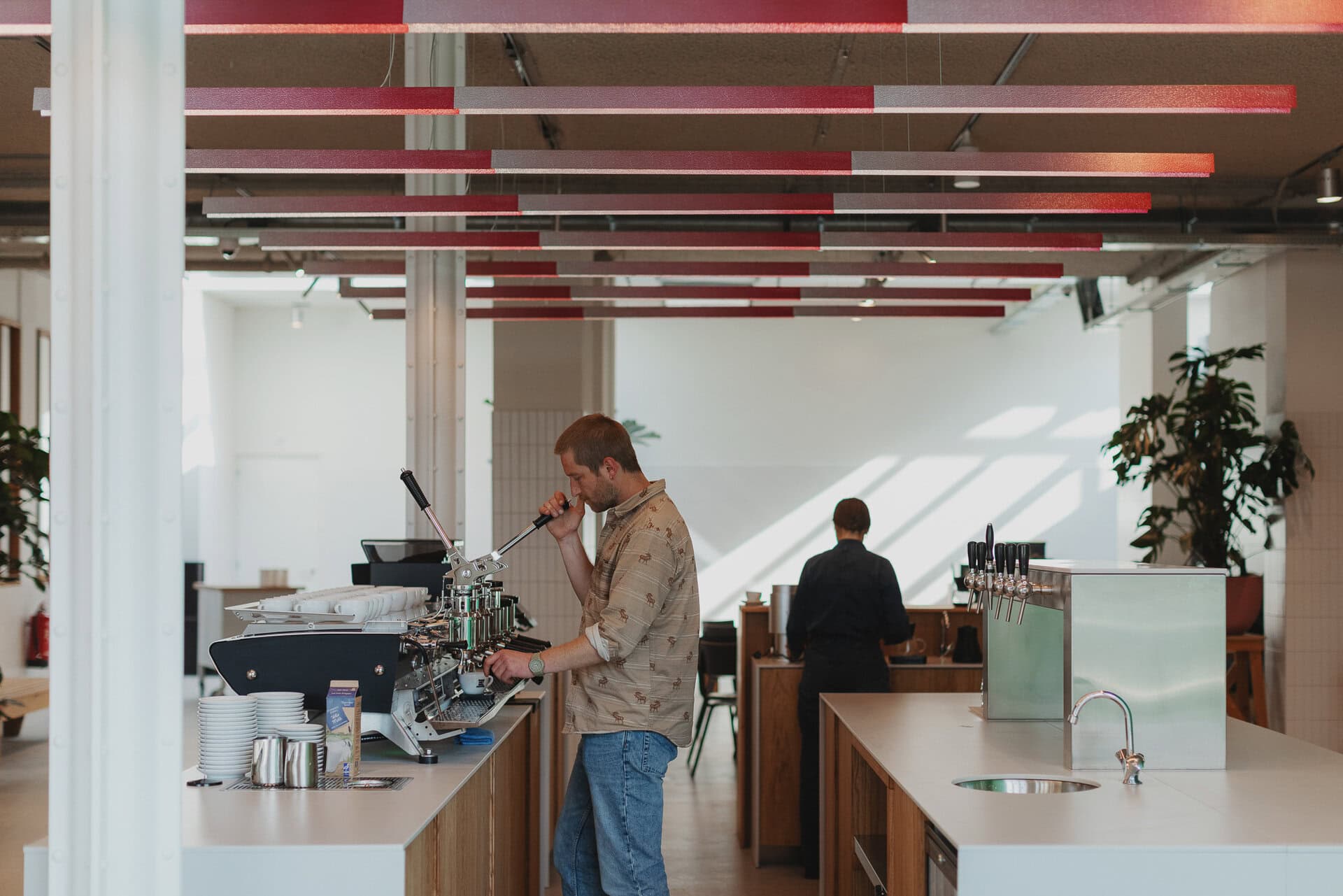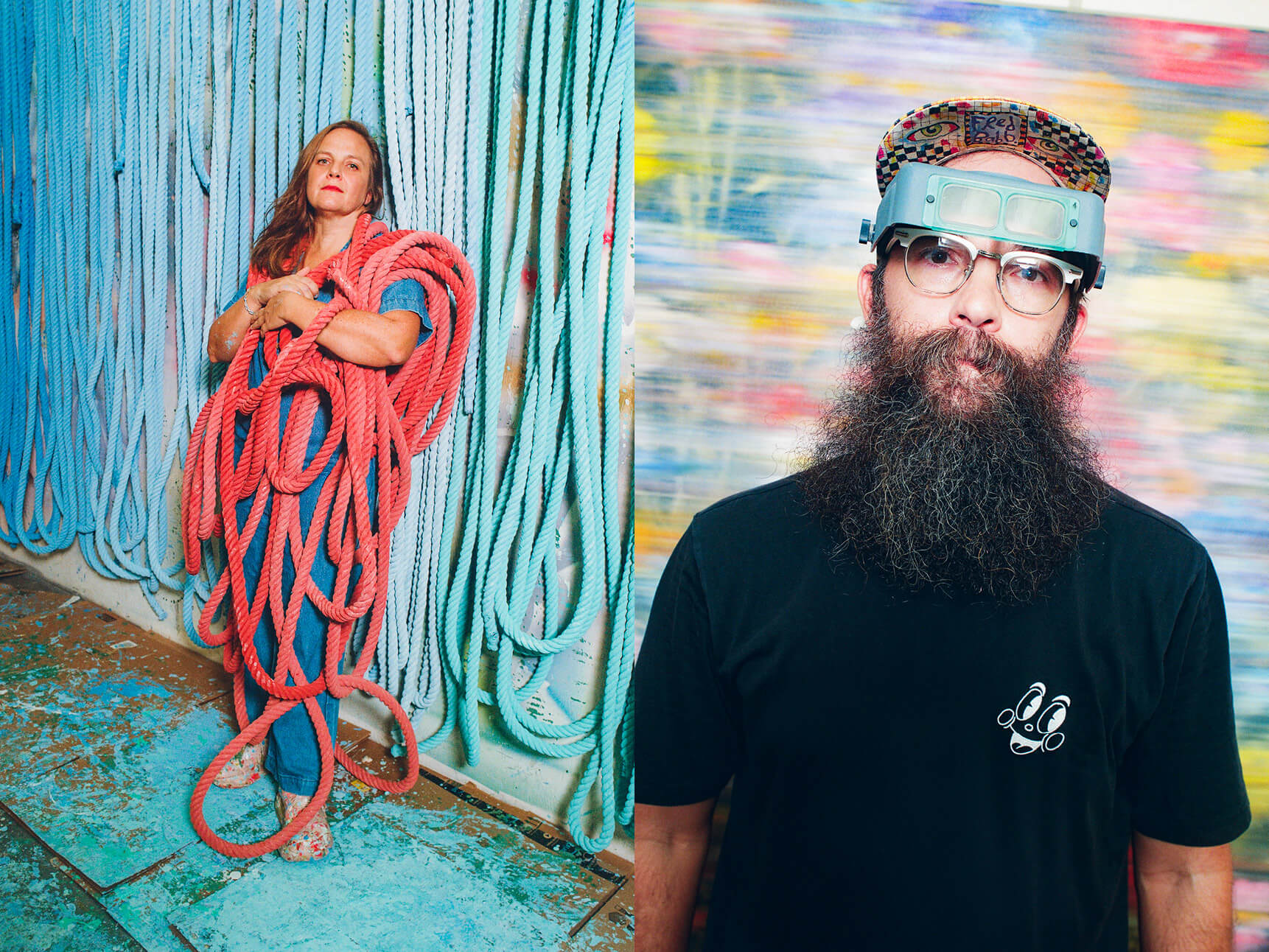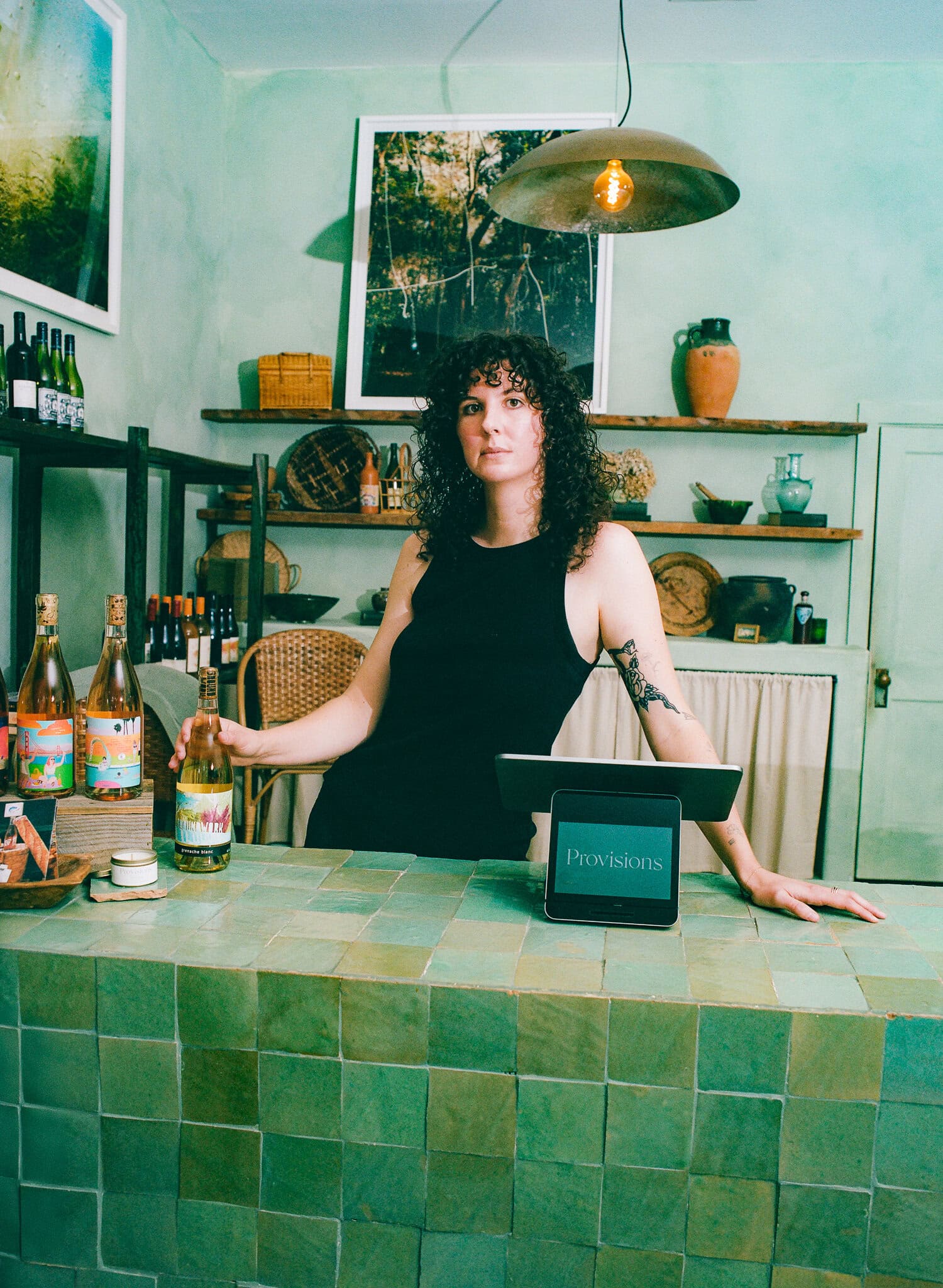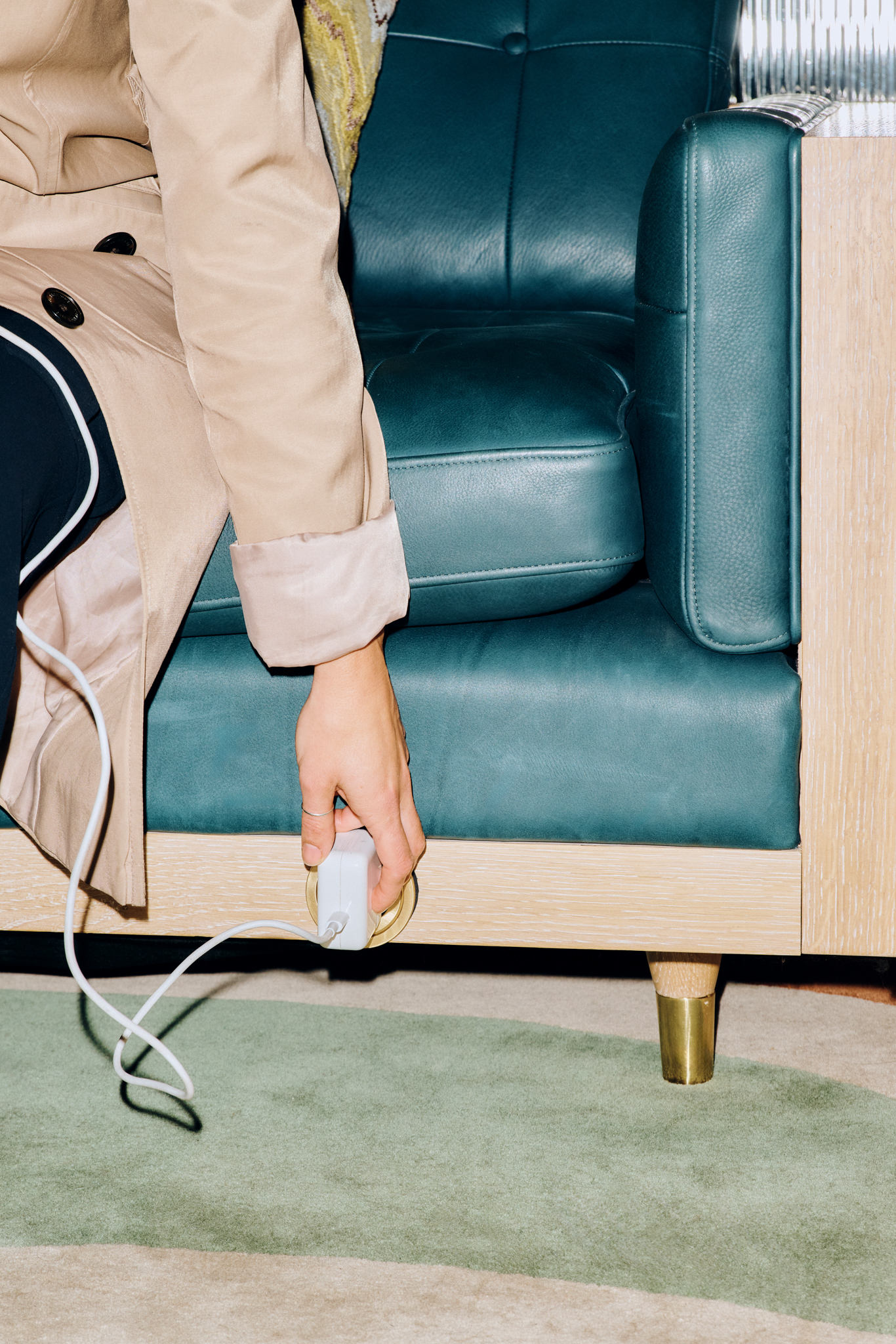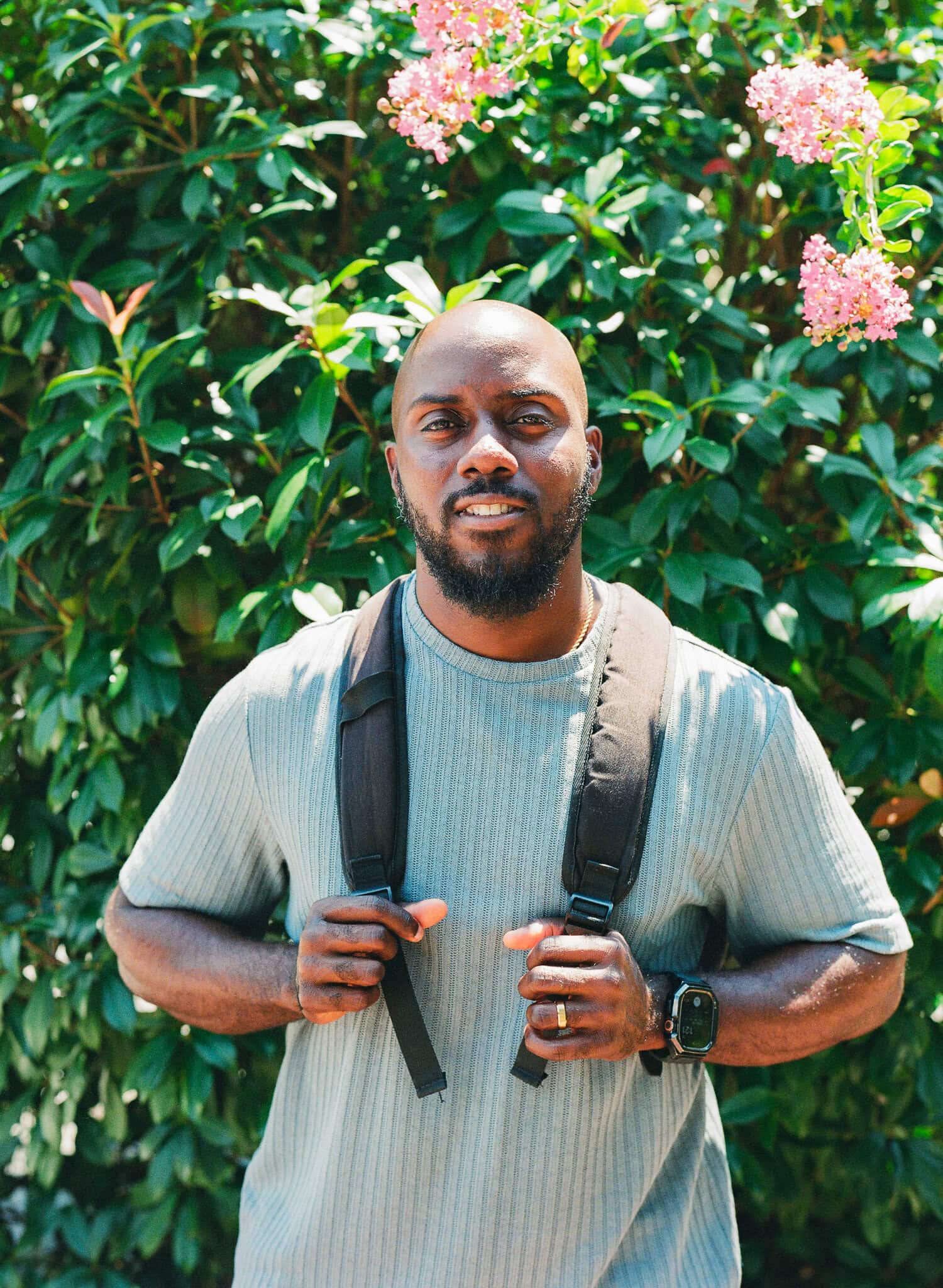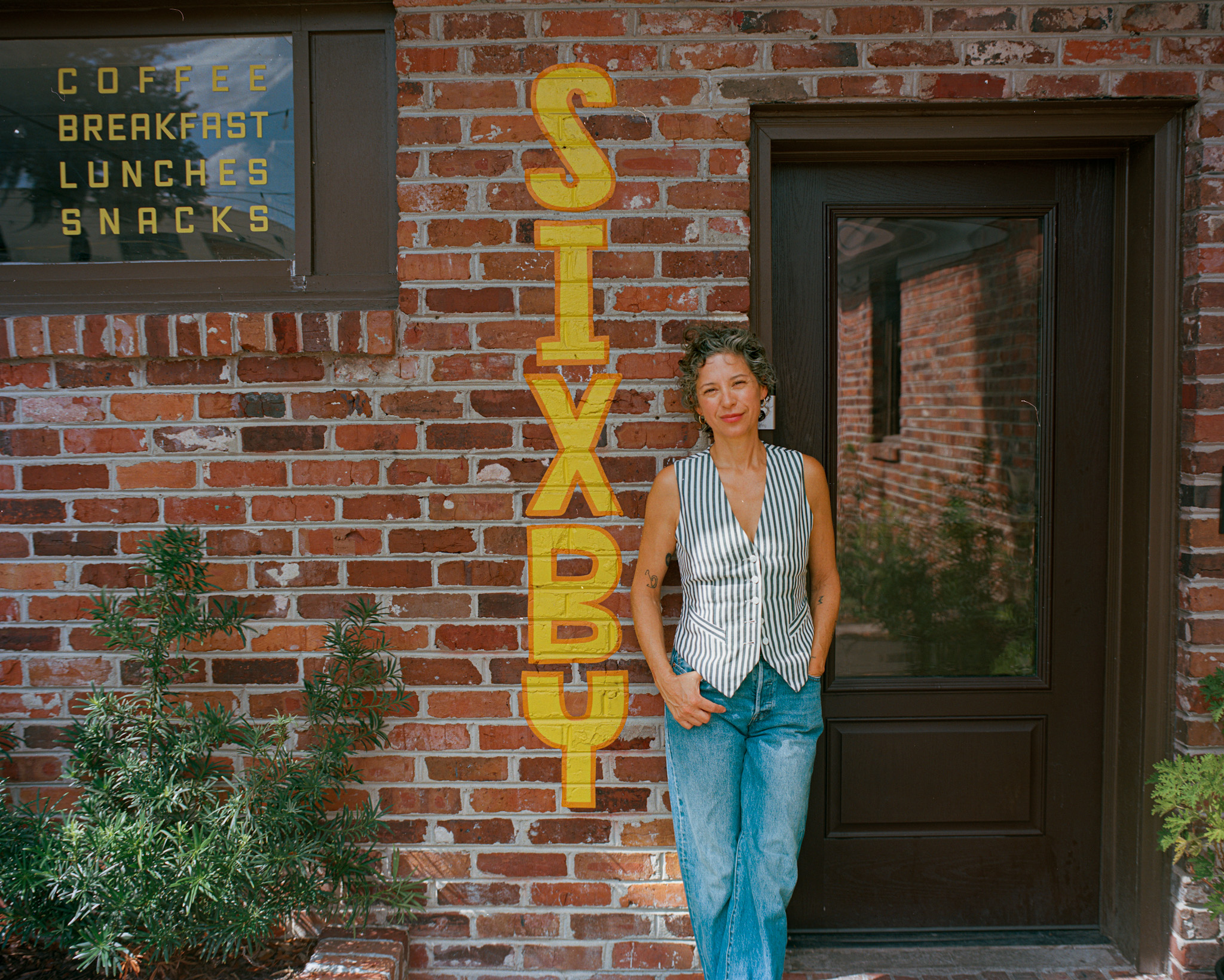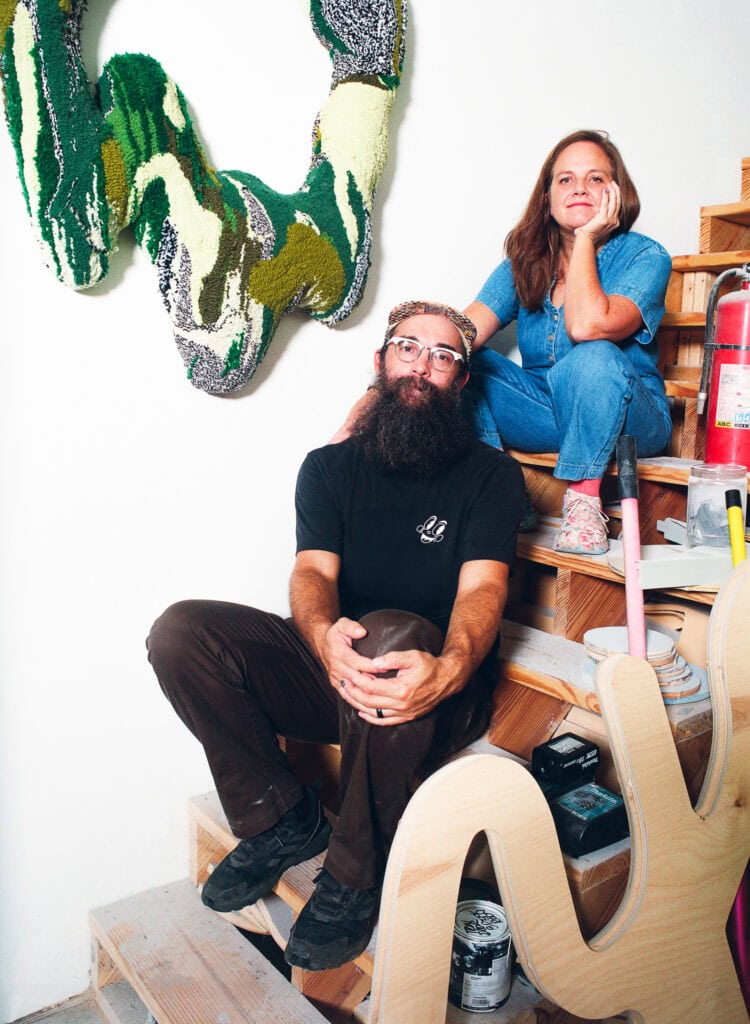
Trish Andersen and Michael Porten are partners in life and art.
Both graduates of SCAD, they’ve built distinct practices while sharing a common creative language—one that comes to life in their individual projects as well as in the collaborative work they produce together. From milestone shows to a new home studio in the works, the pair addresses their lives as Savannah-based artists and how the city continues to shape their perspective and practice.
How did each of you first get started in art?
T: I have loved art for as long as I can remember. I had leukemia when I was very little. Some of my first memories of creating are when I was in the hospital and playing in the art room. It’s no wonder I still use art today as my way of processing the world around me. I went to SCAD (Savannah College of Art and Design) initially to study graphic design but quickly realized I wanted something more hands-on, so my focus was ultimately on fibers.
M: I liked to draw from a young age, and as I developed my interests, I also enjoyed the challenge of tangling the visual language with ideas. Of all the fun things to do for a job while being alive, this field seemed the most rich with possibility, and the most limber in terms of expression.
Who or what have been the biggest influences on your work—whether artists, movements, or even experiences outside of art?
T: I am very influenced by process and material. Creating work is my meditation and medicine. My interests have of course shifted throughout my 20 years as a working artist, but currently, I’m in a split love affair with yarn and rope.
M: I love how precise Sargent was with his tone, and his ability to abbreviate form and light. Bernini and Folkert de Jong are constantly whispering in my ear. I enjoy the overproduction of modernism, and the call for change in postmodernism. My biggest influence is probably Vonnegut, as he was very concise in his intentions, and slapped the truth in people with wit.
Your individual approaches are quite distinct. How do you each describe your process and what drives your work?
T: My work has shifted over time, but for almost 10 years now I’ve mainly been working with yarn and a tufting gun. I usually explain it as “painting with yarn,” using this rug-making tool that looks like a drill but works like a sewing machine. I grew up in Dalton, Georgia—the “Carpet Capital of the World,” where wall-to-wall tufted carpet was invented—so it feels like coming full-circle in a way. I found tufting when I was really burned out and looking for some kind of spark. The first time I got my gun to actually work, I cried—I hadn’t felt that excited and alive in so long. I guess I’d say I’m driven towards always finding that feeling.
M: I don’t have a set material or process that I use, though I do love traditional painting and sculpture, and I enjoy using technology to fart around with it. Most of the work I’ve done in one way or another is an attempt at describing the world around me. Sometimes an idea about form drives the conversation, as I’m trying to figure out a “what if” regarding materials. Sometimes I have something to say, and circumstance chooses the best medium. Finding an idea worth executing can be difficult. Some ideas appear with ease, often as a response to whatever is happening in front of me. Sometimes they creep from the periphery.
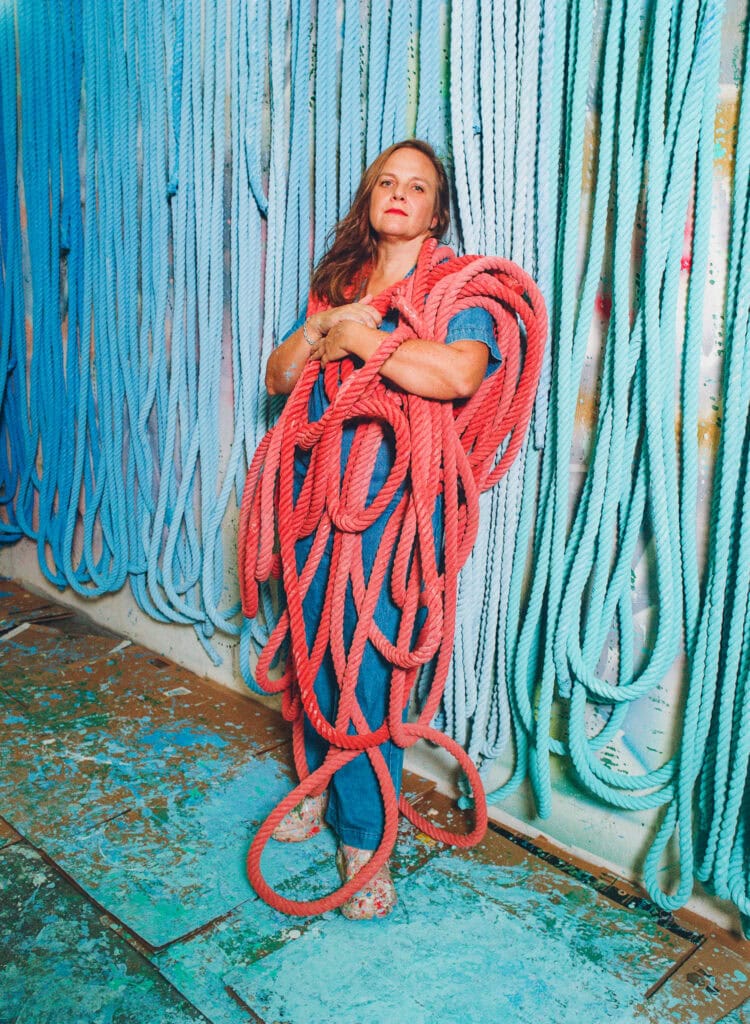
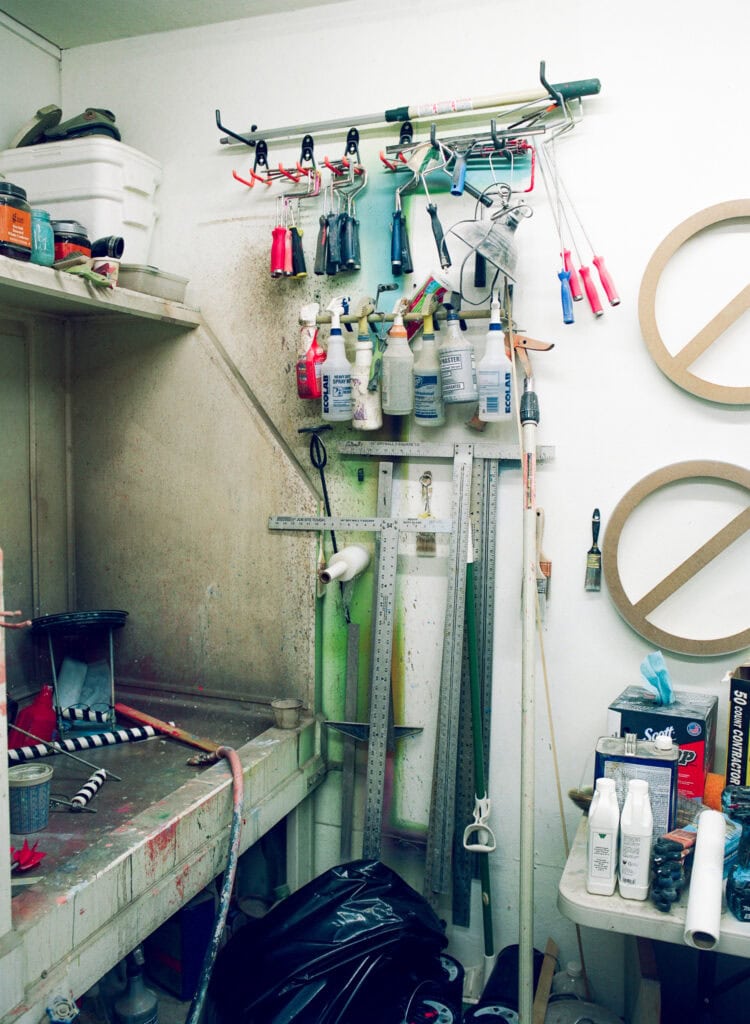
Looking back, is there a milestone project for either of you—something that shaped your career or marked a turning point?
T: Funny enough, when I first started tufting I swore I wasn’t going to make rugs. I didn’t want to get stuck in something purely functional—I felt like I had more to say than what a rug could hold. When I first moved from Brooklyn to Savannah, we rented this run-down (but amazing) old house. My studio was on the first floor and we lived upstairs. Our landlord was also an artist, so he let us fix it up however we wanted, which felt like such a gift.
At some point we were trying to get our cats to run the stairs for exercise, and I decided to break my own rule and make a rug for them. Since Michael is a painter and I’m a fiber artist, I thought it would be fun to make it look like paint was spilling down the stairs in our favorite colors. It was just for us—I wasn’t thinking about selling it or what people would think. One day I casually posted it, and it ended up going completely viral. That exposure gave me the chance to really lean into my fiber work. It was a reminder that if you create something you truly love, it’s going to resonate with others too.
M: What’s funny is that the cats mostly chose to run along the sides of the stairs. I was so excited to see them come screaming up the middle of the stars, which of course they did, but more often than not, they did a causal sprint up the side. In terms of milestones for me, the piece at the Mercedes-Benz Stadium taught me a lot, and helped me buy an industrial CNC machine. I’d say I’m still waiting on the truly life-changing project to come along… I’ve got a few self-funded projects I’m trying to get off the ground that might change some things.
When did you first begin collaborating, and how has that dynamic evolved over time?
T: The first time I met Michael—maybe 12 years ago—we actually got paired together on a SCAD project called SCADpad. Our work is really different, but there’s always been this natural aesthetic conversation between us. We didn’t become a couple until later, but from the start we were always helping each other on projects and giving feedback. Kinda crazy, but aside from our house and other small things, we hadn’t actually collaborated on something from the ground up until last year, with our show Wild Frontier at Laney Contemporary.
M: Right, collaboration that starts from inception is relatively new for us. The Laney show was a good start, but all the big “what if“ ideas that we had while making that show are what I really want to see.
You recently presented a collaborative show together. What was the starting point for that project, and what did you each bring to it?
T: Wild Frontier was our first show together and it happened to open on Walt’s first birthday [their son]. It seemed only fitting that we would do a show centered on our ultimate collaboration—Walter—and our shared experience of becoming parents. We made works that combined both of our mediums, curated with some of our solo works. I especially love the Wild Frontier series. They were these plastic, splatter-cast bust sculptures of Michael with tufted raccoon skin hats. I am excited about our shared studio getting finished—I see a lot more collaboration in our future.
M: I think the starting point was us talking with Susan Laney and saying, “Hey, we should do a collaborative show!” Past that, and thanks to her support of the idea, we put our heads together on making it happen. We both are used to helping each other with our individual processes, and it was really nice to be able to merge our processes together. For example, resolving the edges of a text piece is very tedious work for me, as I like to make objects clean if they are calling to be clean. Being able to let that go and replace the edge with a tufted strip was just simply easier and looked better.
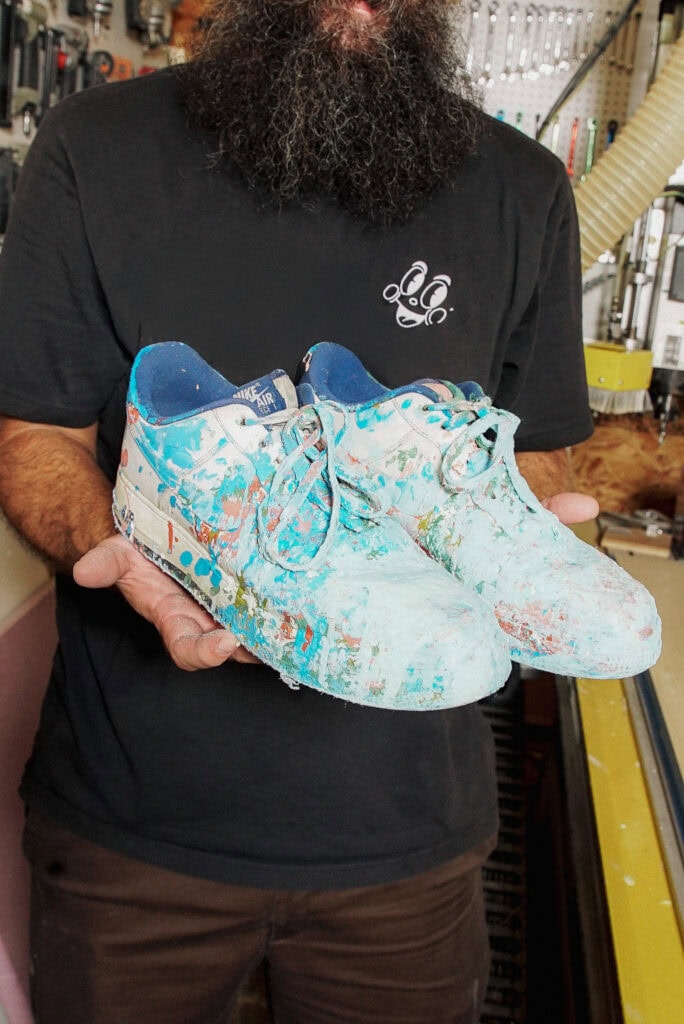
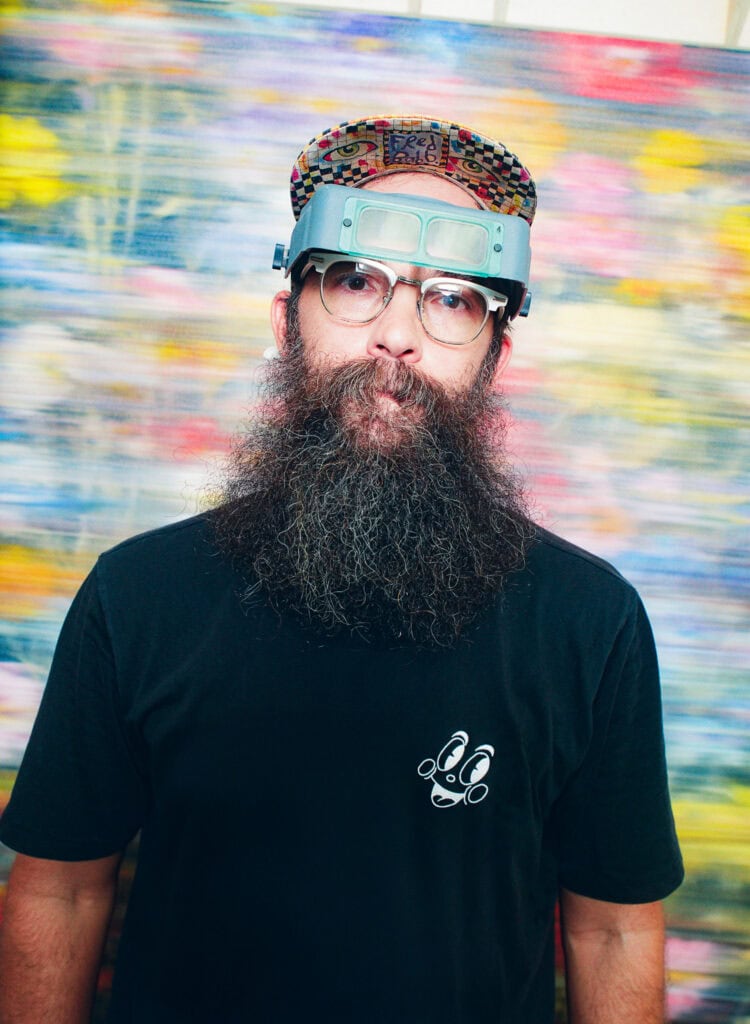
What are you each working on right now that feels especially exciting?
T: I just finished a bunch of sculptures and installations I made out of over 7,000 feet of painted rope. It’s a material I played with years ago, but it got pushed to the back burner when I discovered tufting. It’s fun to revisit. I love (and hate, ha!) how physical it is. I get bored very easily, and it has presented me with a new set of challenges, which always fuels me.
I am also leaning into the floor more and breaking my “no rug” rules. I think it’s a surface that is often underutilized and I’m having fun thinking of large-scale, floor-based rug installations.
M: Right now I’m welding up some doors and windows for the new studio we are building. We’re hoping to have the power company come give us the juice soon, and that will be very exciting! I’ve also been making some large blurry wild flower paintings. That’s a new process for me, and it’s been fun to explore.
Savannah is both home and backdrop for your work. What does the city mean to you personally, and how does it filter into your art?
T: I moved back to Savannah after 14 years of living in Brooklyn. I had just started getting into tufting, and it’s no surprise that Savannah’s dripping moss, the puffs of the marsh grasses, and the sinuous lines of the tree branches have influenced my work. I loved being in the city, but I needed a change, and Savannah was the perfect soft landing spot. More than it being beautiful, I thrive on its pace and ease. I was ready to slow down. It allows me to really think and focus.
M: This place is unique, beautiful, and now the birthplace and home of our son. It is also the home of SCAD, which is a huge umbrella for the surrounding art community. Savannah is growing and bringing new opportunities to artists here. I recently collaborated with my friend Will Penny to make a sculpture/video projection piece for the new Hyundai factory. There is a lot of tourism here, and hotels and restaurants that need artwork as well.
Savannah’s art scene has grown significantly in recent years, with SCAD playing a central role. How do you see the city’s creative community today, and where do you think it’s headed?
T: It is refreshing to see! When I lived here during college, most people left after school, so I was pleasantly surprised when I started coming back and saw how the art (and food) scene had grown, and how many people were staying in town. There are a lot of creatives moving back here, too, which is awesome. I have no clue where it is headed, but I am stoked it is all happening.
M: Yeah, I think Savannah is always redefining itself, and we happen to have a good amount of people that like to make, buy, sell, commision, and exhibit art! SCAD is obviously the biggest fish in town regarding all of those things. Where is it all headed? I imagine we’ll see more people coming here, and coming from here, that have something to say with the arts. I’d like to see broader partnerships with the arts and surrounding industry. More traditions that spring up to celebrate being alive in this place.
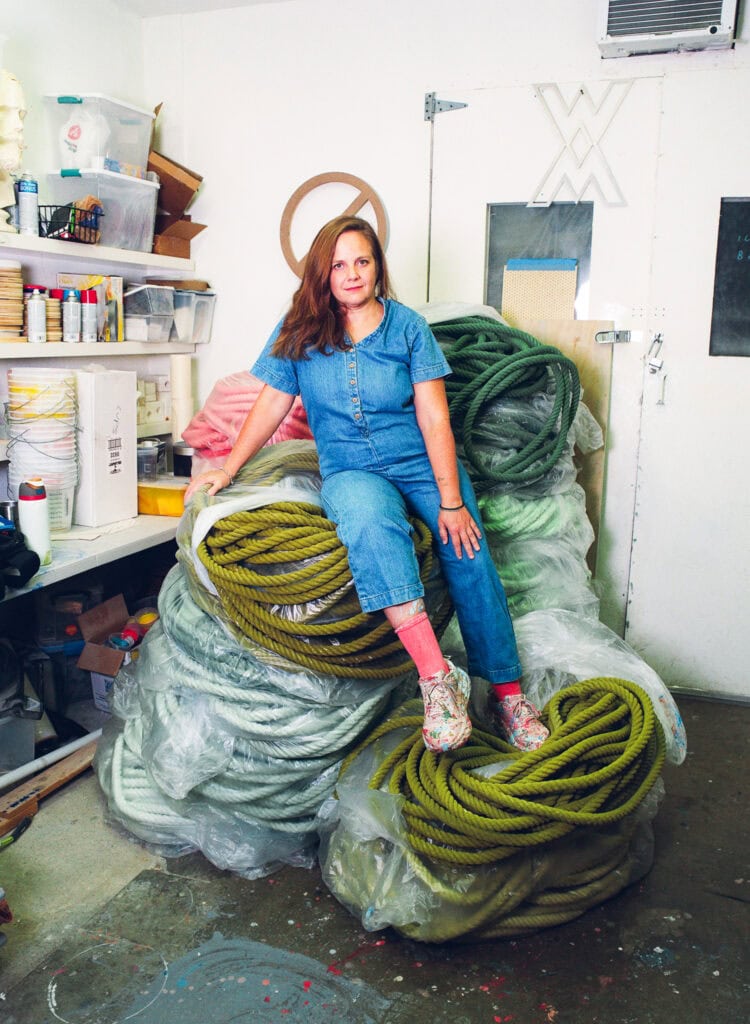
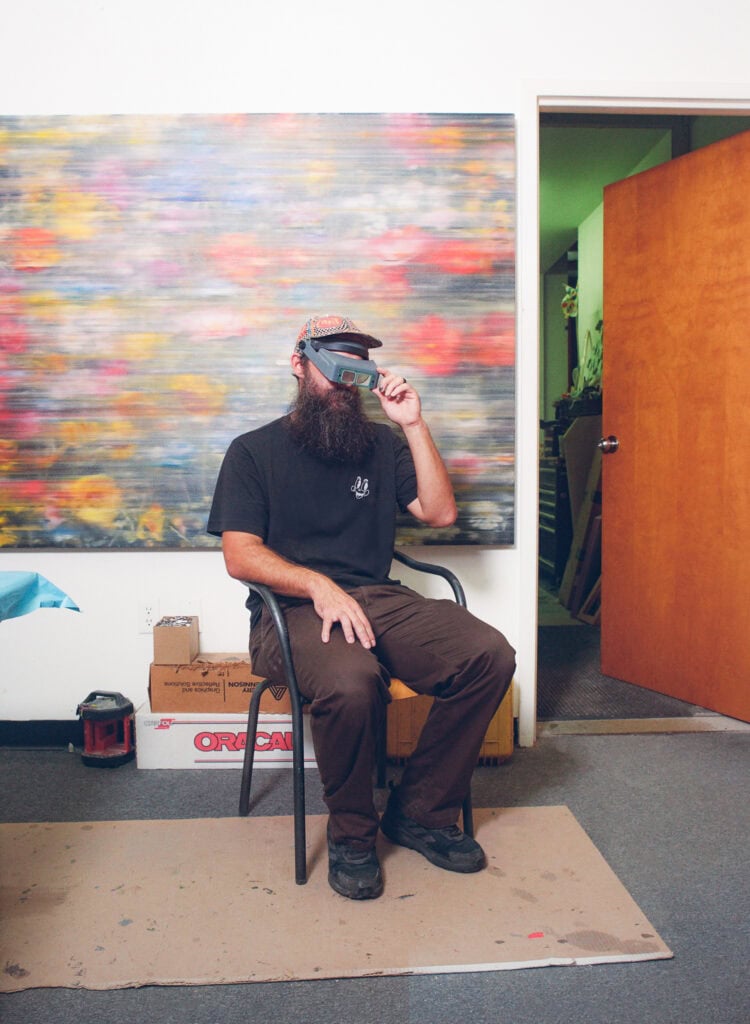
You’re currently building a new home studio. What does having that dedicated space mean for your work and your life?
T: The world! I have been paying rent for studio space in Brooklyn and Savannah for the last 18 years… add that up! Beyond the financial impact I am just so ready to not have to fear a landlord raising the rent on me. It is becoming increasing difficult for artists to find sustainable space to work in either location. I work large and so I have to have a dedicated space or my home wouldn’t function. ha. Having the studio in our backyard will be such a dream and will help us have more time to be together as a family. I love the efficiency of a (very) short commute
M: Yes, Savannah prices are now what New York prices use to be. Maybe worse in some places. In addition to all of what T said, with the most important being spending more time together as a family… I’m looking forward to the peace that we will be able to enjoy from it.
Art and life often overlap—how do you separate the two, or do you prefer to let them blend?
T: I don’t know how we would ever be able to separate them?! Our life/work is one big mash-up and we are just clunking through, chasing the things that feel good. I will say, having our son Walter has taught us how to work less, and slower. Nothing else matters really.
M: I’m thinking about the arrangement of small toys and food items in Walt’s car seat, or how I watched him eat an ice cream cone with a straw yesterday. These things are fodder for future works, and of course, are a couple of uncontrollable surprises in the collection of moments that make up our shared lives. It’s hard to separate the two sometimes, but it is important to think about, and establish, your boundaries and privacy.
What’s one piece of advice you’d give to aspiring artists trying to find their voice?
T: Create what you want to see in the world. Someone told me this early on, and I have found it immensely helpful when trying to tune out the noise.
M: “Don’t hide behind a style.” and “Paint like your momma isn’t watching.” Both came from mentors as I was coming up. Maybe the world around you catalyzes your “voice” without you knowing it. I don’t know. I might direct someone to focus more on learning and growing, and in the event that they have something to say, they will be free to say it in any voice they choose.
Finally—after years of working side by side, how do you continue to inspire and challenge one another?
T: From the day I met Michael I thought he was THE MOST incredible artist (and also super, super cute). To me, he is the smartest and the best, and I feel lucky to get to work next to him and do life together. We aren’t perfect and have no clue what we are doing, but at least we have each other…and our Walter! So I guess my answer is, through appreciation and kindness (some days better than others, because we are human).
M: Wow! Ya. I love you, T! (I’m responding second here, and separately, and reading the above just about got me!) Life can be a grind, and joy is hard to recognize without gratitude and a little rest. Actively recognizing it when it’s there doesn’t hurt! Inspiration is easy, as I am always trying to do my utmost to make life better, in big ways or small, for Trish and Walt. I try to be someone that they can be proud of. When you love someone and think the absolute world of them, that can be a real and constant challenge! I think what is really the challenge for us, though, is putting the work aside long enough to enjoy each other. Humor and kindness and humility and adventure help a lot!
